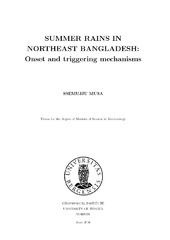| dc.description.abstract | The aim of this study is to shed light on convective triggering mechanisms around the onset of the summer rains in Northeast Bangladesh. We want to understand this rainfall since it has a large impact on the local climate, and because 25.3% of the annual rainfall in Northeast Bangladesh falls in Bangladesh summer (March - May). To do this, we first identified the onset of the summer rains for each year using Sylhet station rainfall data with a 11 mm/day pentad rainfall mean threshold and a 6-pentad algorithm developed by Stiller-Reeve et al. [2015]. Then the onset pentads were used to make lead-lag composites from the ERA-Interim reanalysis data to examine the large-scale situation prior to and after the onset. To see if there were any large transitions, we used the Monte Carlo (MC) method and the Overlap Coefficient (OVC) method to test for statistical significance of the composites. The compositing and OVC results show that there is a large transition in rainfall amount over Northeast Bangladesh at the first pentad after the onset. This rainfall is not a result of the large scale monsoon, because the upper-level winds are westerlies during the onset of summer rains, in contrast to the upper-level easterlies of the large-scale monsoon. Instead, the atmosphere over Northeast Bangladesh is convectively unstable at lower-mid troposphere due to the presence of abundant moisture transported from the Bay of Bengal by the strong low-level winds at pentad +1. Further analysis shows that the heavy precipitation is limited to the southern slope of the windward side of the Meghalaya Plateau where Northeast Bangladesh is situated. Immediately after the onset, a cold pool of air develops over Northeast Bangladesh at 925 hPa. The results further reveal that both the dry-line and the thermal low over India are only confined to the lower troposphere below 600 hPa. Once we had a better understanding of the large scale conditions, we continued to investigate how the diurnal cycle of several parameters change around the time of the onset. The diurnal cycles of precipitation, low-level winds, and total water convergence over Northeast Bangladesh are similar, increasing from 1800 BST and attaining their peaks between mid-night and early morning. However, the diurnal variation of evaporation shows a minimum (maximum) between evening and midnight (early morning and midday), respectively. Based on our results, we see that the conditions around the onset are favourable for several of the triggering mechanisms previously proposed in the literature: 1) orographic uplifting; 2) the nocturnal low-level jet; 3) convergence with the boundary of the cold pool of air present at 925 hPa after the onset; and 4) the dry-line and associated strong mid-upper level westerly flow. Our results also point to the sea breeze circulation mechanism which is not yet discussed in the literature. Finally, we propose that future work on summer rains over Northeast Bangladesh should be based on numerical modeling with a high resolution to fully investigate the mechanisms influencing the summer rains such that a sounding conclusion can be made about their likely causes. | en_US |
